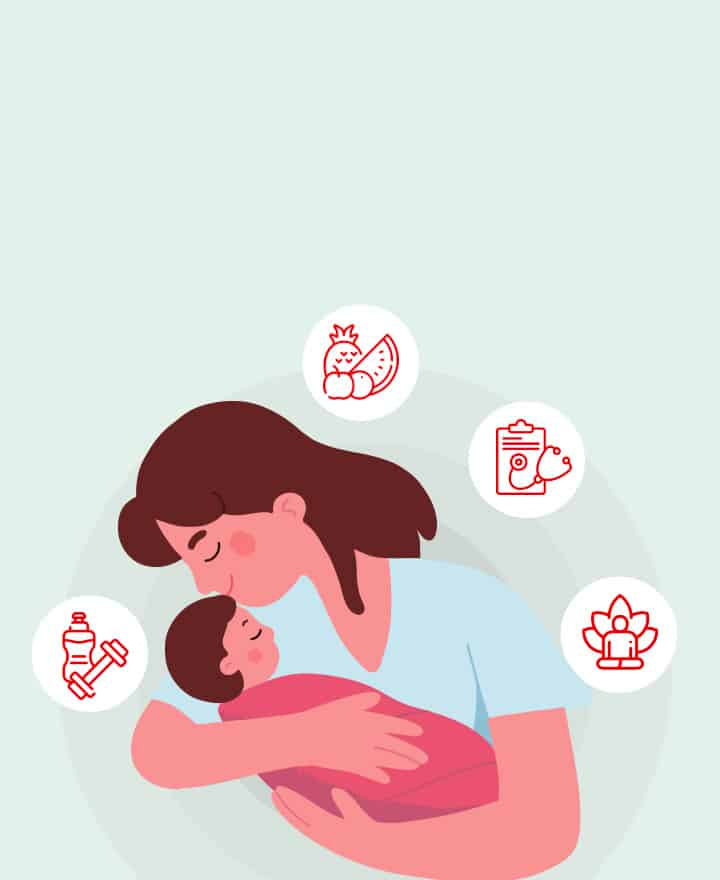
Introduction of Pregnancy Self-Care
Pregnancy is like sailing into unknown waters when you first start your journey. It’s an exciting but intimidating experience with many unexpected turns and breathtaking moments. Pregnancy self-care, or caring for your body, mind, and spirit to ensure a healthy pregnancy and beyond, is the cornerstone of this journey. But what precisely does this period of self-care involve? Let’s get started and examine the fundamentals.
Being Aware of Your Body’s Changes
Changes in Hormones
Your body undergoes major changes during pregnancy, mostly due to hormonal changes. Hormones are essential for pregnancy self-care because they affect everything from mood swings to physical changes. Anxiety, weariness, and mood swings are just a few of the symptoms of pregnancy brought on by elevated progesterone and estrogen levels. You can better manage these changes if you understand them. For example, recognizing that mood swings are common can reduce stress.
Physical Shifts
Your body changes remarkably physically as your baby grows. These modifications may include skin alterations, posture adjustments, and weight gain. One of the most important aspects of pregnancy self-care is adopting a positive mindset to embrace these changes. Your center of gravity may shift, which could throw off your balance. These changes can be managed with small changes, such as wearing comfortable shoes and employing safe lifting techniques. Getting frequent massages or practicing prenatal yoga can also help your body transform while easing discomfort.
Nutrition: Two Meals a Day
Crucial Elements
The foundation of pregnancy self-care is nutrition. Even though “eating for two” is a common expression, quality is more important than quantity. A well-balanced diet full of vital nutrients supports your health and your unborn child’s development. Concentrate on eating a diet rich in DHA, iron, calcium, and folic acid. Leafy greens and fortified cereals contain folic acid, which is essential for preventing neural tube defects. Foods high in iron, such as beans and lean meats, help to support increased blood volume. Calcium from dairy products helps build bones, and DHA from fatty fish supports the development of the brain.
Controlling Fears and Cravings
There may be strong dietary aversions and cravings during pregnancy. Effectively managing these is a crucial component of pregnancy self-care. If you have a sweet tooth, consider healthier options like fruits. Find wholesome alternatives if you have food intolerances to make sure you’re getting all the nutrients you need. You can monitor your cravings and make sure you eat a balanced diet by keeping a food journal.
Exercise: Remaining Vigorous and Well
Safe Workouts
It’s good for you and your unborn child to be physically active during pregnancy. Frequent exercise can lift your spirits, ease common pregnancy discomforts, and get your body ready for labor. Pregnancy self-care includes safe, low-impact physical activities like swimming, prenatal yoga, and walking. You can maintain your fitness level with these activities without overtaxing your body. Make sure it’s safe for you to begin any new exercise program by speaking with your healthcare provider first.
Advantages of Maintaining an Active Lifestyle
Exercise is an essential part of pregnancy self-care because it has so many health benefits. It can increase your vitality, facilitate better blood flow, and enhance your quality of sleep. Being active also promotes stress relief and fosters a closer bond with your child. Recall that maintaining a healthy level of activity—rather than reaching peak fitness levels is the aim.
Psychiatry: Handling Tension and Feelings
Engaging in Mindfulness Practices
A pregnant woman’s emotions can fluctuate greatly. Stress and anxiety may arise from hormonal fluctuations, physical pain, or the expectation of parenthood. Making mental health a priority is essential to pregnancy self-care. You can manage stress and maintain your sense of groundedness by engaging in mindfulness practices like meditation and deep breathing exercises. Making time every day to engage in mindfulness exercises can have a big impact on your general well-being.
Looking for Assistance
If you’re feeling overwhelmed, don’t be afraid to ask friends, family, or mental health professionals for support. Participating in a prenatal support group can also foster a feeling of camaraderie and mutual comprehension. Pregnancy self-care must include emotional support, which will make it easier for you to deal with the highs and lows of the journey.
Sleep: Obtaining the Required Rest
Establishing a Cozy Sleep Environment
Pregnancy requires adequate sleep, but getting enough sleep can be difficult because of physical discomfort and hormonal changes. Pregnancy self-care revolves around prioritizing healthy sleep hygiene. Purchasing a high-quality pregnancy pillow will support your evolving physique and aid in establishing a cozy sleeping space. Maintain a calm, quiet, and cold bedroom to encourage sound sleep.
Creating a Nightly Schedule
A peaceful nighttime routine is yet another crucial component of self-care during pregnancy. Your body receives this routine as a cue to wind down. Engaging in soothing activities like reading, having a warm bath, or doing light stretches can aid in de-stressing and getting ready for sleep. To control your sleep patterns, consistency is essential. Aim to go to bed and wake up at the same time every day.
Hydration: Water’s Crucial Role
Daily Water Objectives
Hydration is essential for both your health and the development of your unborn child. Water facilitates the formation of amniotic fluid, helps with digestion, and supports the pregnancy-induced rise in blood volume. Drink eight to ten glasses of water a day or more as part of your pregnancy self-care regimen. Keep a water bottle on you as a constant reminder to stay hydrated. Fruits and vegetables are other foods that you can include in your diet to help with hydration.
How to Identify Dehydration
Identifying and treating dehydration is a crucial aspect of self-care during pregnancy. Keep an eye out for symptoms of dehydration, such as dry skin, dark urine, and lightheadedness. As soon as you experience any of these symptoms, up your water intake. Additionally, staying hydrated can help avoid common pregnancy problems like urinary tract infections and constipation.
Prenatal Care: Continual Examinations and Screenings
The Value of Regular Visits
One of the main components of pregnancy self-care is routine prenatal care. These examinations give your doctor the chance to keep an eye on both your health and the development of your child, ensuring that any possible problems are dealt with right away. Keep all of your prenatal appointments as scheduled, and do as your doctor advises. These visits typically include physical exams, ultrasounds, and various screenings to track your baby’s growth and development.
Resolving Issues
For effective pregnancy self-care, you and your healthcare provider must have open communication. During your appointments, don’t be afraid to ask questions or voice any concerns you may have. Your provider can offer support if you’re worried about a symptom or need guidance on how to handle the discomforts associated with pregnancy. You can make sure you address everything during your visits by making a list of any queries or worries.
Getting Ready for the Baby: Organization and Planning
Making a Plan for Delivery
Getting ready for the birth of your child can be an exhilarating and daunting experience. Organizing and planning ahead of time is a crucial component of pregnancy self-care. Outlining your preferences for labor and delivery is done when you create a birth plan. While being adaptable is crucial, feeling more in control and ready for the birthing process can be achieved by creating a plan. Talk to your healthcare provider about your birth plan to make sure it meets your medical requirements.
Getting the Nursery Ready
Organizing your child’s nursery is yet another crucial aspect of self-care during pregnancy. Plan to reduce stress at the last minute. Select a crib, stock up on necessities like wipes and diapers, and arrange the baby’s wardrobe. Having a space set aside specifically for your infant can ease the transition and provide you with comfort.
Getting in Touch with Your Spouse
Speaking Honestly
Being pregnant is a shared experience, so it’s critical to keep your relationship with your partner strong. The secret to effective pregnancy self-care is open communication. Talk to your partner about your expectations, feelings, and any worries you may have. This will assist you in supporting and remaining on the same page with one another.
Having a Good Time Together
Pregnancy self-care also includes spending quality time together. Despite the hectic schedule of getting ready for your baby, make time for each other. Spending quality time together, whether on a date night, a weekend getaway, or just a calm evening at home, can improve and fortify your relationship.
Establishing a Network of Support
Connecting with Loved Ones
During pregnancy, having a solid support network can make a big difference. One of the most important aspects of pregnancy self-care is this support system. Never be afraid to ask for support and assistance from friends and family. Their assistance can lessen your workload whether it be with household chores, running errands, or just lending a sympathetic ear.
Taking Down a Prenatal Group
As a part of your prenatal self-care, think about joining a prenatal community or group. These groups can offer a sense of camaraderie, valuable insights, and experience sharing. It’s a fantastic way to make connections with other expectant parents who are experiencing comparable things.
Prenatal Education and Learning: Resources and Classes
Taking Prenatal Classes
One of the most crucial aspects of pregnancy self-care is learning about pregnancy, childbirth, and parenting. A variety of subjects are covered in prenatal classes, such as breastfeeding, newborn care, and labor and delivery. You can gain confidence and feel more prepared by taking these classes.
Making Use of Internet Resources
Using internet resources can help you take better care of yourself during pregnancy in addition to prenatal classes. Expectant parents can access a plethora of resources such as webinars, videos, forums, and articles. Throughout your pregnancy, these resources can offer helpful information and support to help you make well-informed decisions.
In summary
Setting pregnancy self-care as a top priority is essential to navigating the pregnancy journey with confidence. You’re laying the groundwork for a happy and healthy pregnancy by attending to your physical, mental, and emotional health. Keep in mind that every pregnancy is different, so pay attention to your body, ask for help when you need it, and enjoy this amazing journey.


















